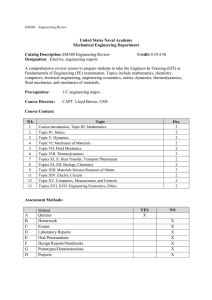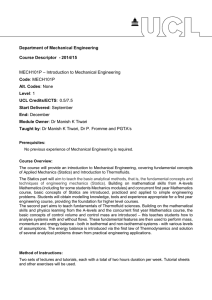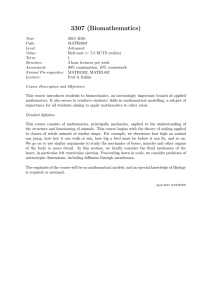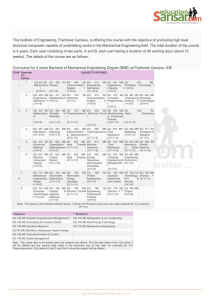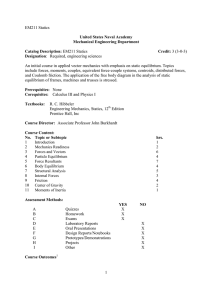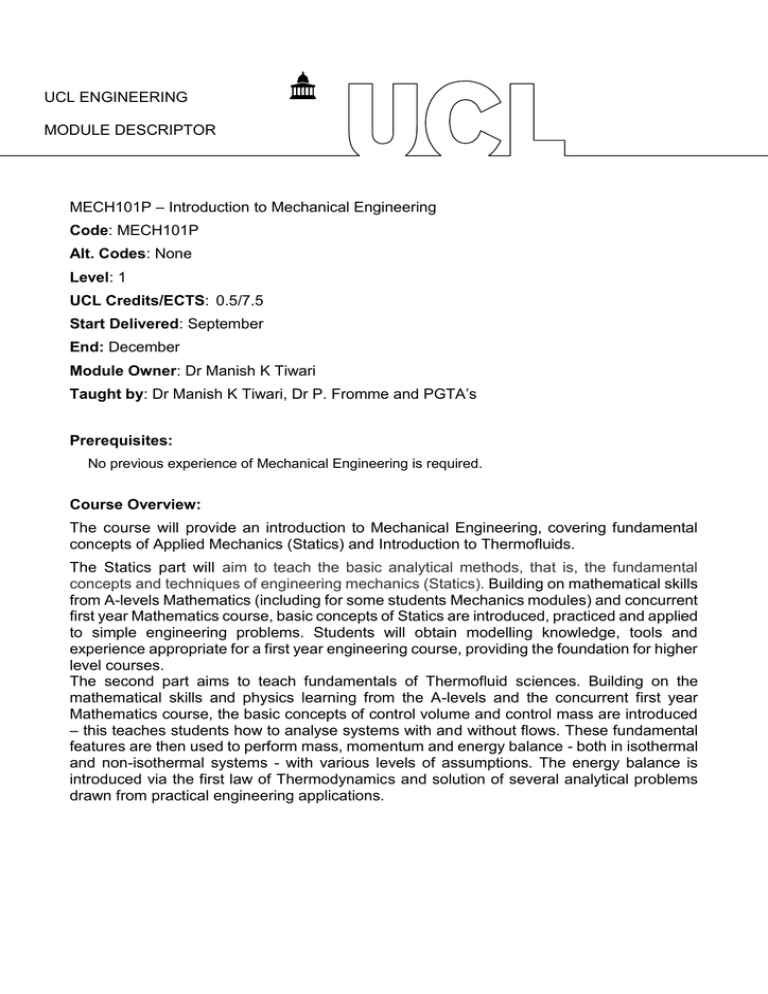
UCL ENGINEERING
MODULE DESCRIPTOR
MECH101P – Introduction to Mechanical Engineering
Code: MECH101P
Alt. Codes: None
Level: 1
UCL Credits/ECTS: 0.5/7.5
Start Delivered: September
End: December
Module Owner: Dr Manish K Tiwari
Taught by: Dr Manish K Tiwari, Dr P. Fromme and PGTA’s
Prerequisites:
No previous experience of Mechanical Engineering is required.
Course Overview:
The course will provide an introduction to Mechanical Engineering, covering fundamental
concepts of Applied Mechanics (Statics) and Introduction to Thermofluids.
The Statics part will aim to teach the basic analytical methods, that is, the fundamental
concepts and techniques of engineering mechanics (Statics). Building on mathematical skills
from A-levels Mathematics (including for some students Mechanics modules) and concurrent
first year Mathematics course, basic concepts of Statics are introduced, practiced and applied
to simple engineering problems. Students will obtain modelling knowledge, tools and
experience appropriate for a first year engineering course, providing the foundation for higher
level courses.
The second part aims to teach fundamentals of Thermofluid sciences. Building on the
mathematical skills and physics learning from the A-levels and the concurrent first year
Mathematics course, the basic concepts of control volume and control mass are introduced
– this teaches students how to analyse systems with and without flows. These fundamental
features are then used to perform mass, momentum and energy balance - both in isothermal
and non-isothermal systems - with various levels of assumptions. The energy balance is
introduced via the first law of Thermodynamics and solution of several analytical problems
drawn from practical engineering applications.
Method of Instructions:
Two sets of lectures and tutorials, each with a total of two hours duration per week. Tutorial
sheets and other exercises will be used.
Additional online and reading materials will also be provided where students are expected
to self-learn. Conceptual ideas learnt will be reinforced through the moderated and student
focused solving of tutorial examples and questions.
Practical laboratory classes (one each for Statics and Thermofluids) related to the
reinforcement of conceptual ideas taught in this subject will be conducted to provide
hands-on experience of engineering structures and systems with mandatory requirement
of attendance but no formal assessment.
Assessment
The course has the following assessment components:
Written Test (2 hours, 80%)
2 Laboratories (20%)
To pass this course, students must:
Obtain an overall pass mark of 40% for all sections combined
The rubric for test is:
Answer a total of FOUR out of FOUR questions. TWO questions will be from the Applied
Mechanics part and TWO from the Introduction to Thermofluids. The students must answer all
questions from each side. All questions carry equal weight.
Resources:
Reading Material
Note that the recommended textbooks may vary each year and the subject lecturers will provide
further information.
1. Mechanics of Fluids: Bernard S. Massey and John Ward-Smith, 9th Edition, Taylor &
Francis.
2. Thermodynamics – An Engineering Approach: Yunus A. Cengel and Michael A.
Boles,8th Edition, McGraw-Hill
3. Principles of Engineering Thermodynamics: Moran, Shapiro, Boettner and Bailey, 7 th
Edition, Wiley
4. Engineering Mechanics: Statics, R.C. Hibbeler (SI Units), Pearson – Prentice Hall
2
Online Support
Identify how Moodle and any other online resources will be used to support the learning in the course.
All course material (lecture notes, tutorial sheets, numerical answers etc.) and supporting
material will be made available to students on Moodle.
Additional Information:
None.
Content:
Applied Mechanics - Statics
1. Forces and Moments
1.1. Introduction
1.2. Force Vectors
1.3. Force Definitions
1.4. Moment of a Force – Scalar Definition
1.5. Vector Representation of a Moment and Resultant Moment
1.6. Static Equivalent Reduction of a System of Forces
2. Rigid Body Equilibrium
2.1. Conditions for Rigid Body Equilibrium
2.2. Free Body Diagram (FBD)
2.3. Support Reactions
2.4. Weight and Centre of Gravity
2.5. Equations of Equilibrium
3. Friction
3.1. Static Friction
3.2. Kinetic Friction
3.3. FBD for Friction
4. Analysis of Structures
4.1. Simple Trusses (Planar Pin-Jointed Frame)
4.2. Method of Joints
4.3. Zero-Force Members
4.4. Method of Sections
5. Distributed Forces and Centre of Gravity
5.1. Resultant of Distributed Forces
5.2. Static Equivalent Reduction of a Distributed Force System
5.3. Centre of Gravity and Centroid of a Body
6. Internal Forces and Moments in Structures
6.1. Internal Loadings in a Beam
6.2. Beams with Concentrated Loads
6.3. Beams with Uniformly Distributed Loads
6.4. Differential Equations
3
Introduction to Thermofluids
1 Introduction to thermodynamics and the related concepts of fluid mechanics
Continuum
What is flow?
Basic properties such as density, viscosity and surface tension
2. Fundamental principles and properties of fluid media
Pressure and temperature
Concept of system properties (intrinsic and extrinsic)
Zeroth law of Thermodynamics
3. Analysing systems and devices
System and surrounding
Control volume and control mass
Principles of mass, momentum and energy balance – introduction
Hydrostatic pressure calculation
4. Pressure and hydrostatic head
Container shape independence
Manometers
Concept of pressure head
Gauge and vacuum pressures
5. Mass balance and energy in isothermal conditions
Applications of continuity equation
Ideal Bernoulli equation
Concept of static and dynamic heads
Venturi
6. Flow analysis
Pressure drop
Reynolds number (Laminar and Turbulent flows)
7. Principle of energy conservation
First law of Thermodynamics without flow
Heat and work equivalence
Internal energy
Control mass calculations
8. First law of Thermodynamics with flow
Control volume analysis
Steady state steady flow
Examples of power plant components
9. Applications of First Law
Ideal gas equations
Examples from engine and power plants
4
General Learning Outcomes:
Knowledge and Understanding
Upon completion of this module students should be able to:
Demonstrate knowledge and understanding of the essential facts, concepts, theories and
principles underlying Statics, Thermofluids, Systems and System Boundaries.
Skills and attributes
Upon completion of this module students should be able to:
Demonstrate knowledge and understanding of the essential facts, concepts, theories and
principles underlying fundamentals of applied mechanics and thermofluid sciences. Teach the
basic analytical methods, that is, the fundamental concepts and techniques of engineering
mechanics (Statics) and thermofluid sciences.
Develop ability to apply appropriate quantitative techniques and mathematical tools to the
analysis of problems arising in applied mechanics and thermofluid sciences. Building on
mathematical skills from A-levels Mathematics (including for some students Mechanics
modules) and concurrent first year mathematics course, basic concepts of Statics and
thermofluids are introduced, practiced and applied to simple engineering problems.
Have a physical feeling for key mechanical engineering components such as an internal
combustion engine. Have an appreciation of the wider multidisciplinary context of the
underlying theory, including its applications to engineering design and application to real world
problems.
5

